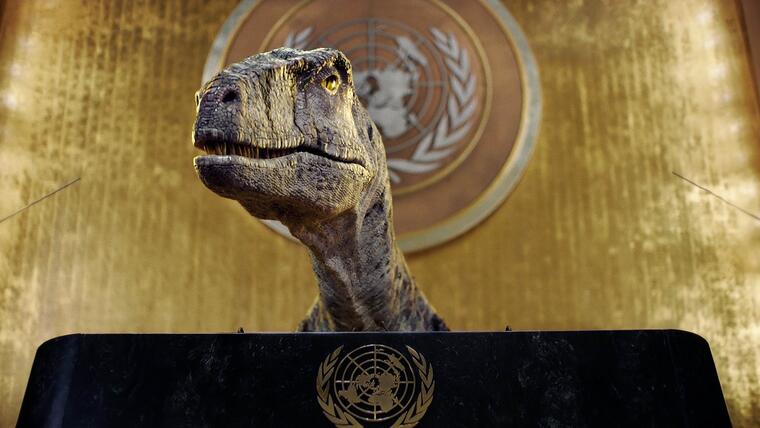By Tom Metcalfe -
NBC News
The discovery of a fossil of a 66-million-year-old dinosaur embryo preserved in its egg, within days of apparently hatching, shows the striking similarities between theropod dinosaurs (characterized by their functional three-toed limbs) and birds. in which they would evolve, according to a study published Tuesday.
The fossilized bones of the embryo, dubbed
Baby Yingliang
in honor of the southern China museum where it was discovered, can be seen curled up inside its elongated 15-centimeter egg shell and
looking almost identical to a
modern
bird
in that phase, albeit with tiny arms and claws instead of wings.
Fion Waisum Ma, a paleontologist at the University of Birmingham in the UK, said the head is especially striking because of its similarity to that of a freshly hatched bird.
This resemblance is accentuated by the beak, which was a characteristic of the species of dinosaur called oviraptorosauria (known for stealing eggs).
Julius Csotonyi's drawing shows a life reconstruction of an oviraptorosaur embryo about to hatch, based on the new specimen.Julius Csotonyi via Reuters
Ma is one of the main authors of the study on the fossil published in the journal
iScience and in which scientists from China, Canada and other parts of the UK also participated.
Oviraptorosaurs, a type of theropod dinosaur with hollow bones and three-toed limbs, were very close to the ancestry of dinosaurs that
evolved into modern birds.
In addition to beaks, they had feathers on their arms.
They could not fly, but there is evidence that they extended their feathers above their nests to keep the eggs warm, explains John Nudds, a paleontologist at the University of Manchester (UK), who was not involved in the study.
They are extremely rare fossils
Embryonic dinosaur fossils are extremely rare: paleontologists have found them in only half a dozen places.
This is the first time that one has shown signs of a distinctive posture known as tuck-in — head under the right arm — although some other dinosaur embryos have shown distinctive "egg teeth," which may have been used to emerge from their shells, Nudds pointed out.
Ma explained that
so far the tuck-in posture has only been seen in birds
.
"Some embryos are quite well preserved, but they do not show this position," he confirmed.
"And some are very fragmented, so it is difficult to see their position clearly."
Dinosaurs were about to become extinct 10 million years before the asteroid
July 1, 202101: 45
Young birds adopt this posture with the head tucked under the right wing in the egg a few days before hatching.
Embryos that do not adopt it well can rarely hatch properly.
Ma noted that tucking
seems to help hatchlings make their first cracks in their shells
,
by restricting the movement of their heads.
"It's easier to stabilize the beak and direct it to the same place when trying to hatch," he explained.
A position given by evolution
The researchers suggest that the tuck-in posture evolved because oviraptorosaurs had hard shells, like those of birds, rather than soft shells, like those of turtles.
This early form of shell was still common about 70 million years ago among dinosaurs such as the protoceratops, which was
the size of a sheep
.
Scientists believe that hard shells protect the environment better than soft ones, so oviraptorosaurs and other related dinosaur species may have developed the tuck-in posture to break through the harder shells, Ma reflected.
View of the oviraptorosaur embryo, one of the best-preserved dinosaur embryos on record.Lida Xing / Reuters / via REUTERS
The
Yingliang Baby
was in a set of fossils that was delivered in 2000 to the Yingliang Stone Museum of Natural History, located in the Chinese city of Nan'an, possibly after being found at a construction site in the nearby city of Ganzhou.
It wasn't until 2015
that one of the museum's employees examined the fossil egg and realized that what appeared to be bones could be seen in a fracture.
The fossilized egg has been scientifically analyzed and the fossil has been divided in order to see the complete skeleton of the embryo coiled in its shell.
More evidence is needed
The study suggests that the fossil is between 66 and 72 million years old.
The baby dinosaur would have measured about 15 inches from beak to tail and could have grown to over 6 feet as an adult.
[Fossils of a new species of armored dinosaur discovered]
Modern chicken eggs, much smaller than
Baby Yingliang
, take about 21 days to hatch.
Scientists do not know how long it was developing in its egg before it was fossilized, but
everything indicates that it was about to be born
, according to Ma.
Many dinosaur experts have hailed the fossil as one of the best preserved embryos they have seen so far.
But some are not sure that what researchers have interpreted as a tuck-in posture in the embryo is really that.
The UN brings a dinosaur to its headquarters to warn about the danger of the climate emergency
Oct. 29, 202100: 28
"This is an interesting discovery, but I am skeptical about the withdrawal behavior, as it is mainly based on a single specimen," said Shundong Bi of Pennsylvania's Indiana University.
"I think more evidence is needed."
Bi, who was not involved in the latest research, studied the fossil remains of another oviraptorosaur hidden in a clutch of 24 eggs, many of which contained embryos.
The interpretation of the tuck-in posture depended on the dinosaur eggs having pockets of air, like the eggs of birds.
But that couldn't be seen in this fossil, and it hadn't been seen in other dinosaur eggs, Bi said in an email.

